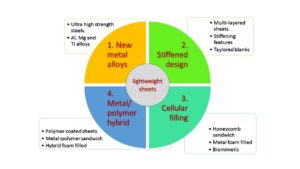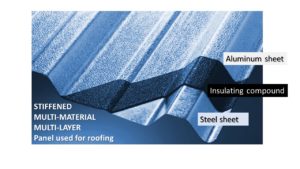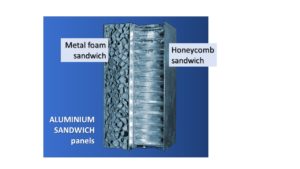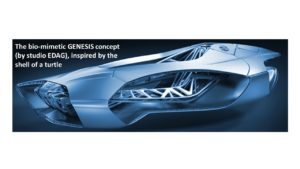The trend towards saving resources and lightweight design is the dominant motivation for the majority of development projects in industry. Lightweight design can be pursued by adopting one or more of the 4 strategies described as follows
1. New Metal Alloys
 Choosing a material with optimized weight / performance and weight / cost ratio is the main road to lightweight design.
Choosing a material with optimized weight / performance and weight / cost ratio is the main road to lightweight design.
New Steels. Steel sheet components are the most widely used material in the automotive sector: 60% of the total weight of a vehicles is made of steel components. The usage of steel as an automotive sheet metal component is expected to remain strong over the future years. The replacement of conventional deep drawing steel with new metal alloys, with increased strength-to-weight and stiffness-to-weight ratio is the most important and most diffused way of reducing the weight and the cost of sheet metal structures. The trend of increasingly using high strength materials with reduced thicknesses is especially represented by the development of advanced high-strength (AHS) and ultra-high-strength (UHS) steels. From the elaboration of various micro-alloyed steels in the mid-1970s of the last century, there is a continuous pressure on material development leading to the appearance of new advanced steel materials practically in each five year. Nowadays, several micro-alloyed and phosphorous-alloyed steels both with and without bake-hardening are frequently used. An increasing use of Interstitial-Free (IF) steels, dual-phase and TRIP-steels, as well as the ultra low and super ultra low carbon steels can also be observed. Advanced high strength steels are emerging, with UTS of up to 1700 MPa.
Light Alloys. Because of the increasing demand for environment-friendly vehicles requiring reduced fuel consumption and weight, besides steel as structural material, aluminum alloys in automobiles are also widely used in car manufacturing for body-in-white production and their ratio will further increase. New material selections are frequently available to the users for alloys of the 2000, 6000 and 7000 series. Aluminum and steel have always been the two most important industrial alloys. However, other light materials for structural applications with densities below 4.5 g/cm3, such as titanium alloys (especially Ti6Al4V) and magnesium alloys (especially AZ31) are assuming and increasing importance, generally outside the automotive sector.
Forming at Elevated Temperatures. The most noble motivation lightweight design is to favor environmental sustainability. A less noble but equally important motivation is the economical saving associated with thickness reduction. If a new ultra-high-strength steel alloy costs 10% more than the previous conventional solution but reduces the thickness of the sheet by 15%, saving is very easy to calculate. Unfortunately, thinner sheets have a decreased resistance to fracture during forming and processing operations. More importantly, It is well known that any increase in strength properties lead to a decrease in the ductility of the materials. Advanced alloys, which are very hard and very thin, are virtually impossible to be worked at room temperature. For this reason, several warm and hot forming processes for sheet and tubes are being continuously developed. Hot stamping is more complex to be designed and controlled, it is a more expensive process and it is also slower than cold stamping. The obvious economic and environmental advantage of using thinner and harder sheet is partly reduced by the need for additional pre- and post-processing treatments, new processes, new machines, new specialised skills of the personnel.
2. Stiffened Design
 Stiffening Elements. The use of stiffened sheet metals architectures. The stiffening of sheet materials is usually accomplished by conventional forming operations such as rolling, embossing and hydroforming. Sheet metals with stiffening vaults or ribs can be found in several applications, from the automotive to whit goods to architectural and building products. An important consequence of stiffened design is that additional functions can be achieved, in addition to weight savings, such as the reduction of noise and the reduction of friction.
Stiffening Elements. The use of stiffened sheet metals architectures. The stiffening of sheet materials is usually accomplished by conventional forming operations such as rolling, embossing and hydroforming. Sheet metals with stiffening vaults or ribs can be found in several applications, from the automotive to whit goods to architectural and building products. An important consequence of stiffened design is that additional functions can be achieved, in addition to weight savings, such as the reduction of noise and the reduction of friction.
Multi-layered Metal sheets. Two dissimilar sheet metals, with different properties can be combined, overlapped in a multi-layer architecture. Steel, aluminium and titanium alloys are generally used in multi-material sheets, generally obtained by the roll bonding process. Co-deformation of two metallic materials, such as Al and Ti, bears the potential to gain improved material properties regarding strength and formability. Multi-layered sheets are often used for gaskets.
Tailored sheets. A tailored blank is a unique sheet metal component that combines several grades and / or various thicknesses and / or different coatings at different locations. Tailored sheets can be obtained by welding different patches together before or after forming, or by localised heat treatment or by localised surface treatment. The different patches welded together allow to place the best material at the best place in the right thickness for a real “tailor-made” solution for the customer after stamping. Tailored blanks are nowadays especially in use in the automotive construction.
3. Cellular metal filling
 The concept of multi-layered sheet can be further modified by using three layers: two outer skins made of compact metal sheet and one internal filling or reinforcement, made of cellular metal. This design allows to obtain a lightweight structure, stiff and highly resistant to impacts. The unit cells which make the internal reinforcement can be open or closed, regular or random, uniformly sized or graded. Open cells are used for non-structural applications. Regular, designed unit cells have better mechanical properties but are also made with more expensive manufacturing processes. The size and shape of each cell could be optimized, in order to generate a local grading of mechanical properties, which can significantly enhance the performances.
The concept of multi-layered sheet can be further modified by using three layers: two outer skins made of compact metal sheet and one internal filling or reinforcement, made of cellular metal. This design allows to obtain a lightweight structure, stiff and highly resistant to impacts. The unit cells which make the internal reinforcement can be open or closed, regular or random, uniformly sized or graded. Open cells are used for non-structural applications. Regular, designed unit cells have better mechanical properties but are also made with more expensive manufacturing processes. The size and shape of each cell could be optimized, in order to generate a local grading of mechanical properties, which can significantly enhance the performances.
Honeycomb sandwich. It is a solution traditionally used in the aerospace field and for sport vehicles, generally implemented with aluminium alloys.
Metal Foams. It is a solution traditionally used in the aerospace field and for sport vehicles, generally implemented with aluminium alloys. Several manufacturing routes are possible, less expensive than honeycomb. The resulting mechanical properties exhibit lower stiffness but greater isotropy and energy absorption at large deformation.
Biomimetic design. The frontier principles of design prescribe that lightweight mechanical parts be built with bioinspired materials or with metamaterials, aiming at unprecedented combination of mechanical properties. 3D printing, viz Additive Manufacturing, is the default technology. Bioinspired materials are very often built with a cellular or porous morphology, which imitates the structural materials used by nature in building bones or other tissues. As in real tissues, more material density, strength and anisotropy is required where larger are the loads to be sustained. Since centuries, structural designers have attempted to imitate the trabecular nature of bones, as Gustav Eiffel did with his famous tour. However, the macroscopic mechanical properties of bones do not come only from their inner porous trabecular filling, but also from the interaction between the trabecular tissue and the harder outer cortical tissue.
4. Polymer/metal hybrid sheets
 Stiffness increasing composites consist of two metal sheets and a viscoelastic damping layer in-between: the outer sheet reveals stamped beads which increases stiffness of composite while the inner sheet serves as cover sheet. Hybrid sheet metal composites do show advantages compared to monolithic materials when strength, stiffness, and damping characteristics are set to a global optimum. In other solutions, the polymer layers are not used to provide additional functions or properties which are not typical of metals, such as thermal and environmental protection, etc. Even though the mechanical properties of hybrid sheet metal composites have been improved in recent years, the application of such hybrid materials in the automotive industry is not well-established due to insufficient knowledge about their forming characteristics (e.g. in deep drawing process). This is an important problem, common to all types of multi-material sheets, either with dissimilar metals, cellular metals or with hybrid metal–plastic composite sheets. They may provide outstanding and multiple mechanical properties, but the adoption of conventional, well-established forming methods for the processing of composite structures is still a challenge for the sheet metal working industry. Manufacturing these hybrid materials in a large scale production is too expensive up to the present day. Both composite and high strength materials pose various questions concerning material characterization and modelling, tribological issues, tool making, and forming processes and new dimensions in terms of quality assurance.
Stiffness increasing composites consist of two metal sheets and a viscoelastic damping layer in-between: the outer sheet reveals stamped beads which increases stiffness of composite while the inner sheet serves as cover sheet. Hybrid sheet metal composites do show advantages compared to monolithic materials when strength, stiffness, and damping characteristics are set to a global optimum. In other solutions, the polymer layers are not used to provide additional functions or properties which are not typical of metals, such as thermal and environmental protection, etc. Even though the mechanical properties of hybrid sheet metal composites have been improved in recent years, the application of such hybrid materials in the automotive industry is not well-established due to insufficient knowledge about their forming characteristics (e.g. in deep drawing process). This is an important problem, common to all types of multi-material sheets, either with dissimilar metals, cellular metals or with hybrid metal–plastic composite sheets. They may provide outstanding and multiple mechanical properties, but the adoption of conventional, well-established forming methods for the processing of composite structures is still a challenge for the sheet metal working industry. Manufacturing these hybrid materials in a large scale production is too expensive up to the present day. Both composite and high strength materials pose various questions concerning material characterization and modelling, tribological issues, tool making, and forming processes and new dimensions in terms of quality assurance.



